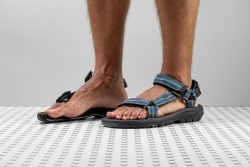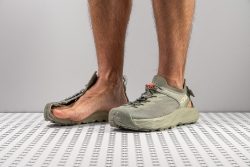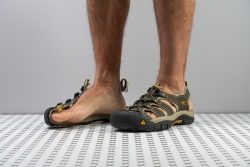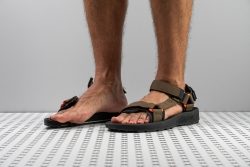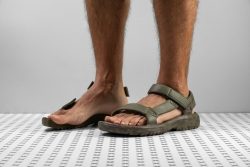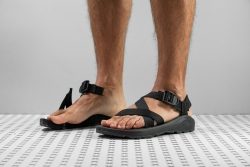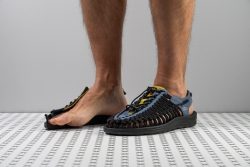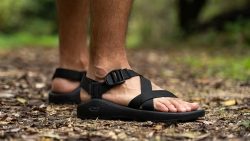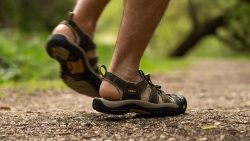7 Best Hiking Sandals in 2025

We buy shoes ourselves. We earn commissions when you buy through us, at no extra cost. Why trust us
Finding the best hiking sandal can be a drag, considering the many options available. But having a basic understanding of what hiking sandals are all about would make a world of difference. Enter RunRepeat and our guide, which you can find below.
To help you narrow down the choice, we have tested hiking sandals out on the trails and in our lab and selected the best ones. Open or closed-toe, water-ready, minimalist - whatever your preferences are, we’ve got a top pick in different categories.
How we test hiking sandals
Why should you trust our best picks, our testing methodology, and our review process? Because we honor these steps:
- We, ourselves, buy these hiking sandals for us to test on the hikes. FYI, we do not tolerate brand-biased opinions here, so we strictly acquire them using our own funds.
- We get to inform you everything about the sandals, from feel, fit, weight, durability, and more, all from our individual experiences. We hike in them on different terrains, whether muddy, rocky, dry. We also cross water streams and pass different obstacles.
- We bring the sandals to our lab to perform standardized tests on them. From flexibility and outsole durability, traction, to lug depth and stack heights, we measure everything.
- We publish our in-depth reviews along with all the lab data so anyone can access them and compare hiking sandals by different features (preferences).
Best hiking sandals overall
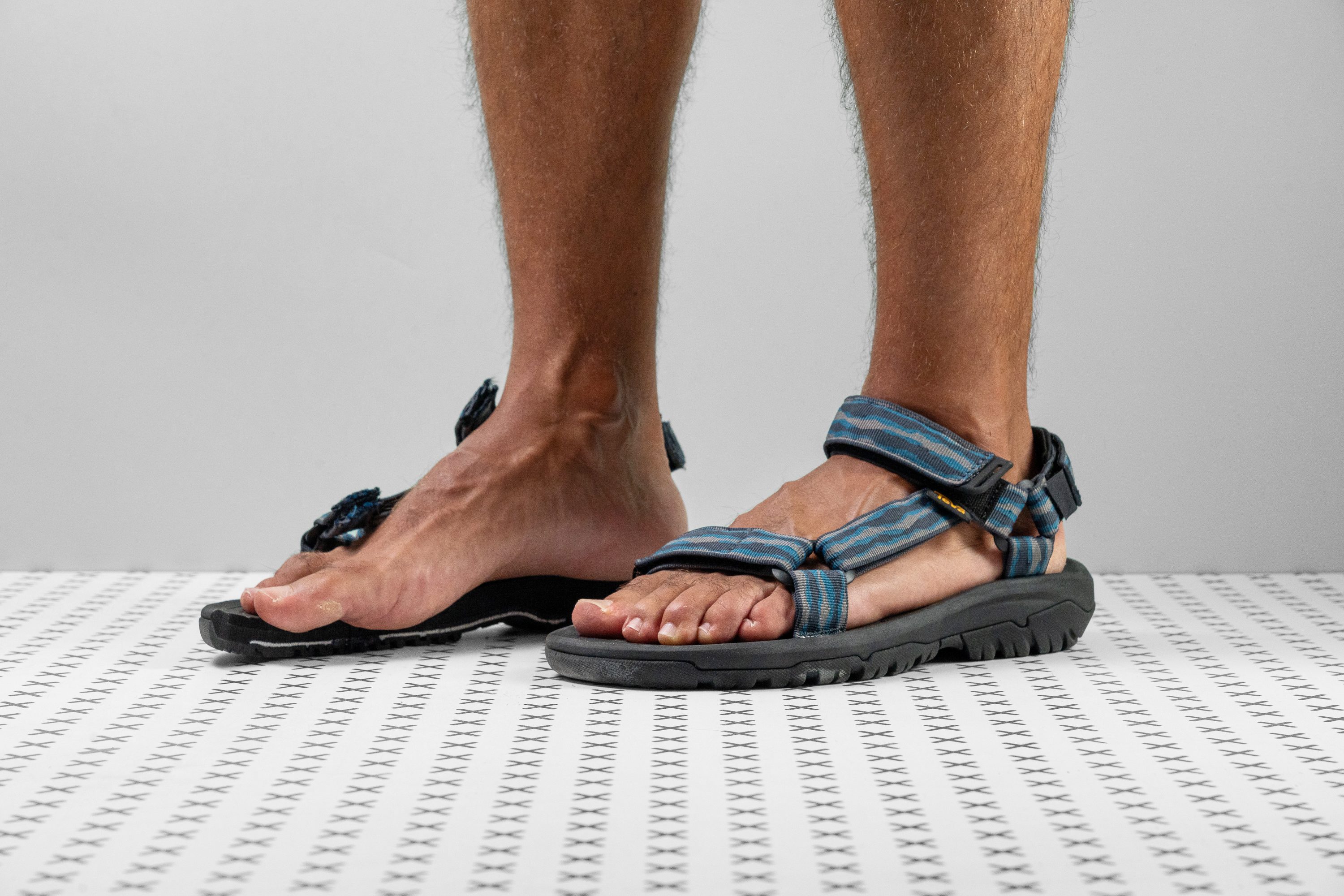






























What makes it the best?
There is more to this classic, colorful sandal than meets the eye. Not only does it have excellent arch support, but the cushioning in this grippy sandal is a cut above the rest. There can only be one best overall hiking sandal, and it’s the Teva Hurricane XLT2.
The arch support in this sandal is a welcome change from the featureless footbeds of most other sandals. The contours and raised arch support our feet and keep our feet secure in the sandal, even while hiking on uneven paths and inclines. It gets a thumbs up from us, especially for hikers with flat feet or overpronators.
Whether we found ourselves hiking on wet or dry rock, loose gravel or shallow mud, the functional triangular pattern on the outsole prevented us from slipping. In the lab we measured the lugs, finding them to be an impressive 3.5 mm. Our lab-tested sandals have 2.5 mm lugs on average. The Teva Hurricane XLT2, on the other hand, is comparable to some hiking shoes. No wonder we felt footsure on our hikes!
This sandal has taken more inspiration from the hiking shoe in the form of cushioning. With a 30.9 mm heel stack height, it is 5.5 mm higher than the average sandal, and approaching the average stack height of 33.5 for hiking shoes. The 11.9 mm heel-to-toe drop almost convinced us that we were wearing hiking shoes, too! It makes for a very comfortable ride, and the sheer quantity of material underfoot kept our feet protected from rocks and other sharp objects.
With such a hiking-shoe-like feel to the Teva Hurricane XLT2, it is easy to forget about watching our step. The open toe leaves us vulnerable to stubbing our toes on rough terrain. Hikers looking for a closed-toe hiking sandal for maximum toe-protection should take a look at the KEEN Newport H2.
Pros
- Highly versatile
- Well-cushioned
- Supportive footbed
- Durable for the price
- Grippy outsole
- Customizable fit
- Lightweight
- Quick-drying
- Affordable
Cons
- No toe protection
- Runs a little large
Hiking sandals with the best shock absorption
















































What makes it the best?
The Hoka Hopara 2 excels for hikers craving all-day comfort and trail protection. With gentle landings, stable grip, and durable build, it boosted our confidence in outdoor excursions, earning the award for best shock absorption among lab-tested hiking sandals.
Despite its bulky appearance, the midsole isn't excessively tall, measuring 26.2 mm in the heel and 23.0 mm in the forefoot. However, it provides remarkable shock absorption, effortlessly eliminating any sensation of rocks or debris underfoot. In our lab test, its score is an impressive 123 SA, 17.1% above average, offering less impact and lasting comfort for extended wear.
Hopara 2’s midsole looks bigger than it actually is because of the tall sidewalls that cradle our feet, adding to its stability. Further contributing to our surefootedness are the 3-mm lugs that bite various surfaces steadily. So far, Hopara 2 is also the widest platform we’ve tested in the lab at 121.9/98.4 mm.
Hopara 2 is our shield with its robust 82.9 HC outsole and strong Cordura mesh panels in the upper, the latter offering excellent water drainage as well. On top of this, the oversized toe cap softens the impact of any roots and rocks we accidentally hit. However, the upper tends to trap sand inside so we recommend using another sandal for beach trips.
Pros
- Comfortable cushioning
- Highly durable construction
- Light for a closed-toe sandal
- Unmatched cushioning and impact protection
- Feels stable and grounded
- Fantastic grip on slippery surfaces
- Plenty of toe room
- Sustainable materials
Cons
- Traps sand easily
- Not for narrow feet
- Color discrepancy
Hiking sandals with the best protection





















What makes it the best?
That distinct silhouette from KEEN is back, this time in the guise of a hiking sandal that is comfortable from day one. Perfect for hiking on established trails on hot summer days, we were astounded by the amount of protection, stability, and grip offered by the KEEN Newport H2, making it our most protective hiking sandal.
There’s nothing minimalist about the sole of this sandal. Our measurements showed the heel stack height comes in at 29.4 mm. That’s 6.7 mm thicker than the average hiking sandal, not to mention approaching the 33 mm average for hiking shoes! The amount of material underfoot keeps our soles protected from sharp objects on the trail, making the KEEN Newport H2 a great alternative to hiking shoes in the summer.
This sandal really shines in the support arena. It has top-notch arch support and feels super stable when hiking along rough and rocky trails. We measured the width of the outsole in the lab and were amazed to find it measures a whopping 121.1 mm at the forefoot and 88.8 mm at the heel. For reference, the average hiking sandal measures 96 mm at the forefoot, and even hiking boots measure 113.5 mm. Best friend of wide-footed hikers, it also explains the stability we experienced on our hikes.
The toe cap keeps our foot protected from stubbing on stray roots, and the sandals grip well in both wet and dry conditions. Our lab measurements backed up our observations - the lugs measure 4.1 mm deep, almost the same as the average hiking shoe (4.3 mm)! For all this support and protection, this sandal tips the scales at 13.4 oz (381g) - 2.3 oz (314g) heavier than average.
For hikers who spend a lot of time adventuring over loose terrain, we recommend looking elsewhere. The enclosed design makes it hard to get dirt and debris out of the sandal without taking it off.
Pros
- Versatile for various hikes
- Exceptionally plush
- Incredible grip level
- Stable and supportive
- Day-one comfort
- Easy and fast to lace up
- Quick-drying
- Stink-proof
Cons
- Heavier than average
- Traps debris
Hiking sandals with the best versatility
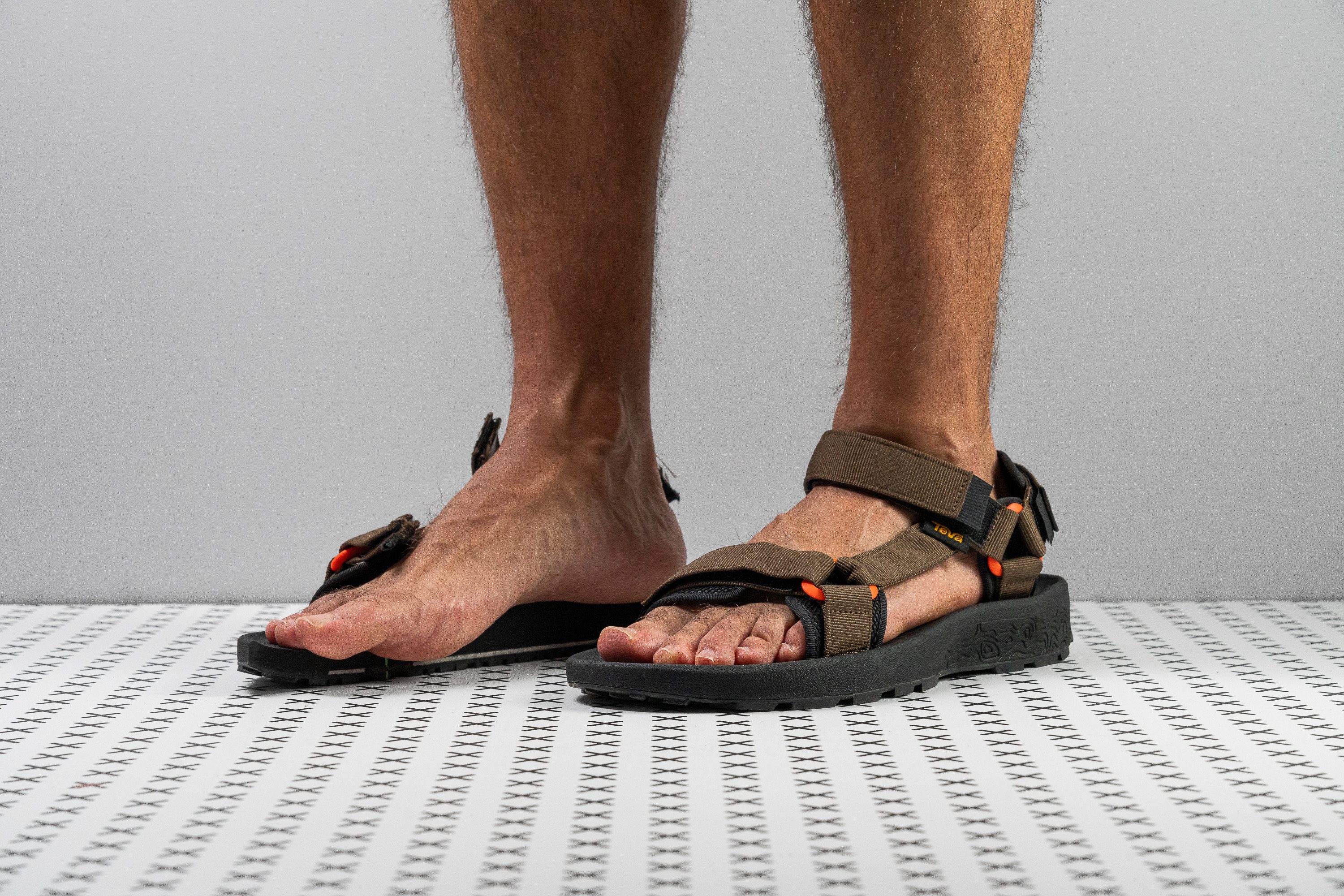

































What makes it the best?
The Teva Hydratek was a welcome respite whenever we wore it for water activities, light hikes, or even casual wear, making it our best versatile hiking sandal. It features a plush midsole that’s comfortable for all-day wear, while its light and loose build freely moves with our feet. In our lab test, it also proved to have a one-of-a-kind grip for wet conditions.
The Hydratek is easy to style and easy to wear. It promotes effortless movement through its airy build, validated by our scale with a below-average 10.7 oz (304g) figure. Bending our feet was a breeze since the midsole barely resisted us. Our flex test confirms it’s 33.0% more agreeable than average. Plus, its springiness felt less taxing on our muscles, offering a solid energy return of 61.1%.
The soft cushioning promotes longer hours on foot, evidenced by our durometer rating of 18.9 HA, 29.5% softer than average. It also protected us from small rocks and shells underfoot and pleasantly supported our arches.
Hydratek’s grip was exceptional between our foot and the sandal and to the ground. The shoe’s top sole has a nice texture that prevents us from sliding whenever we get wet. Underfoot, the soft 77.6 HC and the 2.6 mm lugs delivered solid traction. We felt surefooted during testing since the lug design creates a suction-like effect on wet surfaces. However, dirt gets stuck between them so we recommend washing the outsole right away before it hardens.
Pros
- Versatile: water activities, light hiking, casual
- Great value for money
- Comfortable softer cushioning
- Wide and stable platform
- Enhanced grip on wet surfaces
- Very flexible construction
- Padded straps prevent blisters
- A high % of recycled components
Cons
- Mud gets stuck between lugs
- Fiddly when putting on (pads fold over)
Best floatable hiking sandals
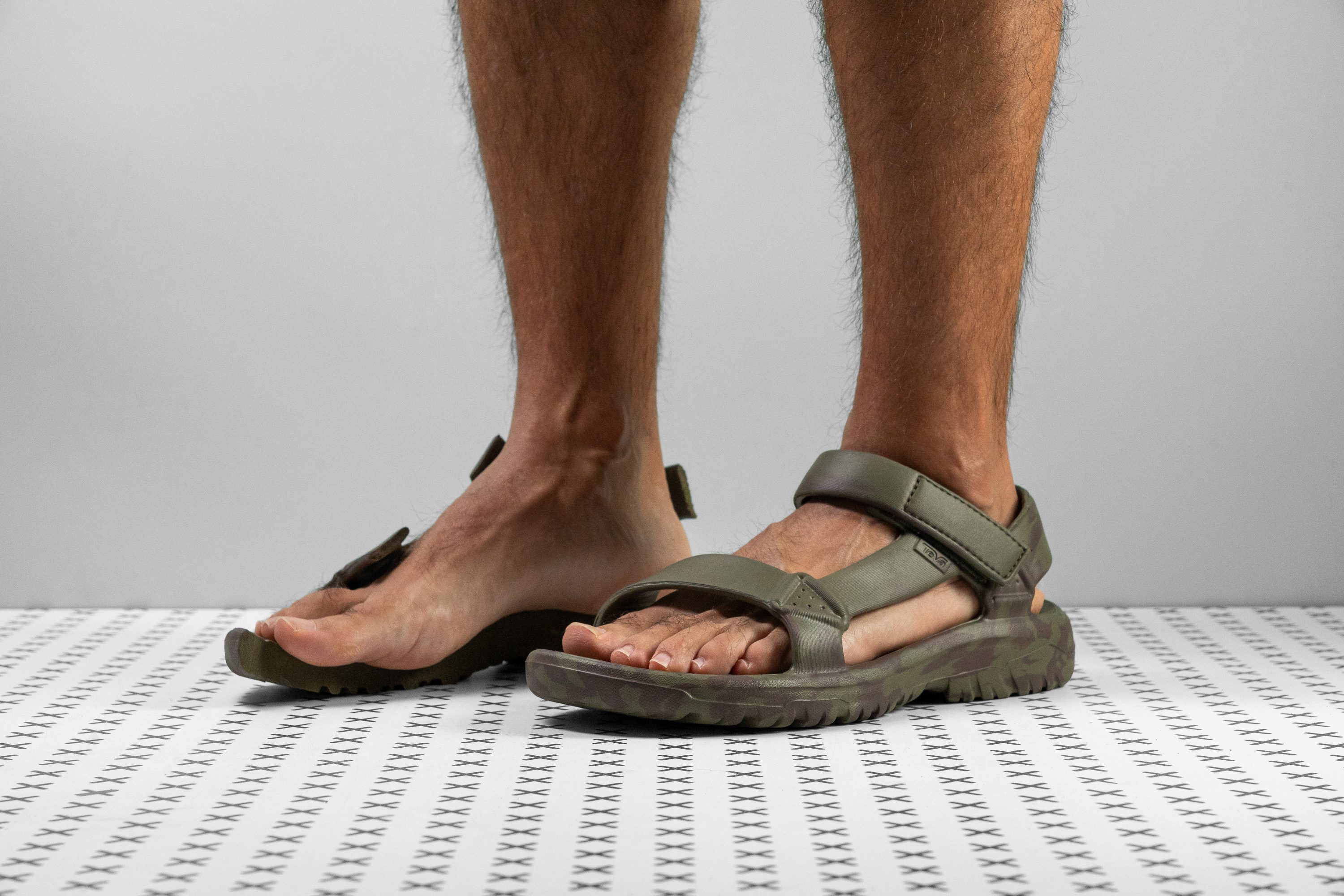




























What makes it the best?
Based on our lab tests and actual submerged adventures, Teva’s Hurricane Drift is the best floatable hiking sandal. It feels light and comfortable on foot as this sandal is made entirely of foam. Even as we venture through river banks and slippery rocks, we remain sure-footed thanks to its grip and stable platform.
Drift gives a barely-there feel. Our scales confirm it’s a light 7.2 oz (204g) vs. the average hiking sandal (9.4 oz/267g). We can swim without worries as this sandal floats right up. We don’t stay wet for long as the foamy straps repel water easily.
We feel at home in the soft cushion, which our caliper measured at 28.9/18.5 mm. Both figures are above average, especially in the heel where impact protection is needed most. The forefoot gives the needed ground feel to navigate tricky terrains better. Our durometer confirms Drift’s velvet touch, measuring 20.6% softer than average.
Grip is a 10/10 as Drift performs effortlessly on our wear tests on slippery and rocky surfaces. Maintaining our balance is a breeze since Drift gives enough width and stiffness to prevent awkward foot movements. The 94.8 mm heel and 105.6 mm toebox are extra wide for stable landings and natural toe splay.
Unfortunately, the forefoot strap is not adjustable. Those of us with narrow feet didn’t get the secure lockdown we wanted.
Pros
- Well-cushioned sole
- Floats on water
- Very affordable
- Among the lightest sandals
- Wide and stable platform
- Grippy outsole
- Doesn't stay wet
- Vivid color options
Cons
- Forefoot strap is not adjustable
- Too loose for narrow feet
- Not for serious hikes
Hiking sandals with the best comfort
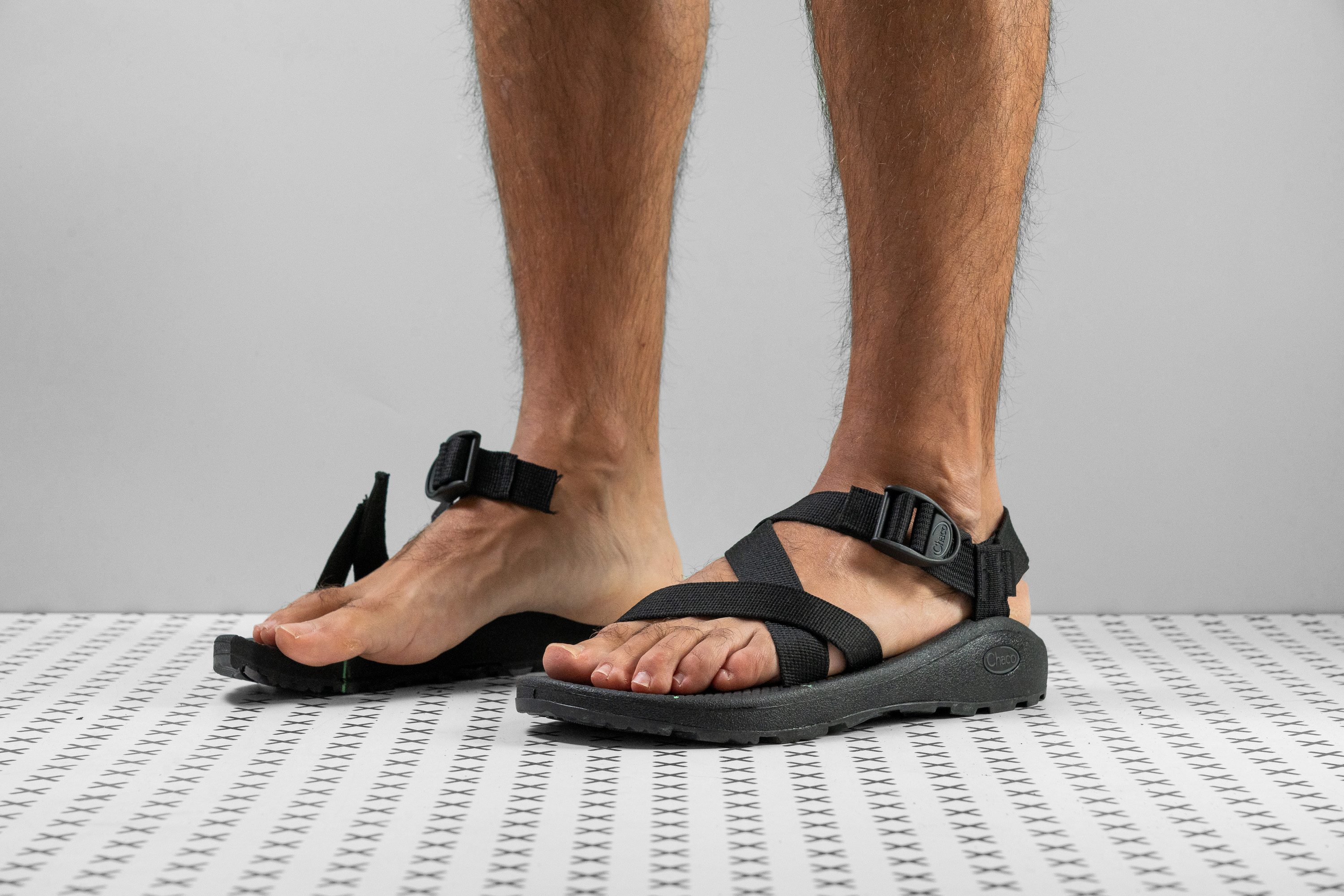





























What makes it the best?
A hiking sandal doesn’t have to be flimsy or minimalist. We decided on the Chaco Z/Cloud as the most comfortable hiking sandal because of the plush comfort it delivers in the midsole and footbed. Boasting excellent grip on loose ground, there is more to the Chaco Z/Cloud than meets the eye.
Chaco’s trademarked Luvseat midsole is made of dual-density polyurethane. On our hikes, we were astounded by the feeling of cushioning balanced with the support that the midsole delivers. Our feet felt stable and supported on rough trails, whilst the squishy material underfoot acted as a shock absorber. The podiatrist-approved Luvseat footbed is blissfully comfortable too, providing superb comfort and support. We experienced all-day comfort in the Z/Cloud – we love the Luvseat!
The ChacoGrip outsole works wonders on loose, soft ground. The 3 mm lugs are designed with multidirectional slipping in mind, and our feet gripped well on cambered trails as well as inclines.
Hikers with narrow feet might find it difficult to get a good fit in the Chaco Z/Cloud. In our experience, it suits average to wide-footed hikers best.
Pros
- Fantastic comfort level
- Very well-cushioned
- Brilliant surface traction
- Super-tough build quality
- Remarkable versatility
- Amazing arch support
- Simple and sleek design
- Keeps stink at bay
Cons
- On the heavy side
- Quite wide
- Dries slowly
Hiking sandals with the best style
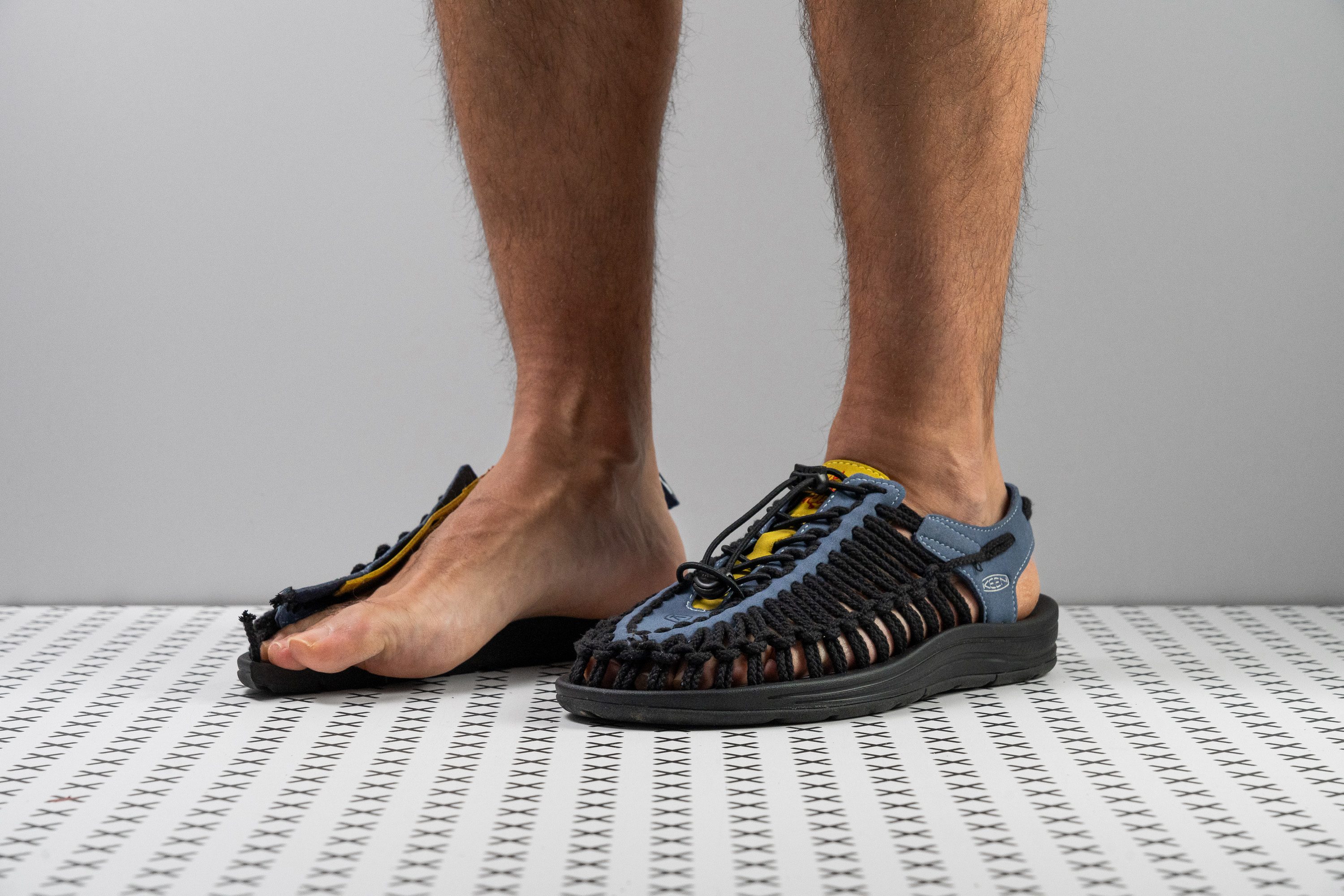































What makes it the best?
Among all the hiking sandals we’ve tried, KEEN Uneek stands out with the best style. This hybrid sandal has a unique structured upper made of cord-rope mesh that feels breezy, flexible, and secure. Comfort is first-class from top to bottom as Uneek’s supportive platform feels great for all-day wear.
Starting with its most fashionable feature, the paracord upper is not only there for design but serves a purpose, too. It feels breezy, and our feet dry quickly as the air flows in and out freely. We have no issues with hotspots or blisters, adding to the sandal’s overall comfort. Our feet feel protected since the material is very sturdy, showing no signs of wear after testing the pair.
The midsole feels light and maneuverable with its low 20.5/12.9 mm platform. Our arches feel supported, and Uneek offers freedom of movement for various activities throughout the day. Our bend test verifies it’s a whopping 50.0% more pliable than average, making it one of the most flexible shoes we’ve seen in the lab.
The outsole’s traction works incredibly well for short hikes, urban wear, and water sports, with 2.2 mm lugs enhancing its bite on the ground. It also features two thin lines in the forefoot and heel to channel water away. Since this general-purpose sandal has a smoother finish, we do not recommend it for challenging terrains.
Pros
- Head-turning cord design
- Ultra flexible construction
- Impressively durable outsole
- Intimate contact with the ground
- Grippy on wet and smooth surfaces
- Feels light and airy on the foot
- Cords made of recycled materials
Cons
- Not much support
- Little protection from debris
Here, we talk about hiking sandals. Flip-flops and slides are NOT sandals. For footwear to be categorized as sandals, they should have straps around the heel so that the heel is always attached to the base and the footwear is not flopping around.
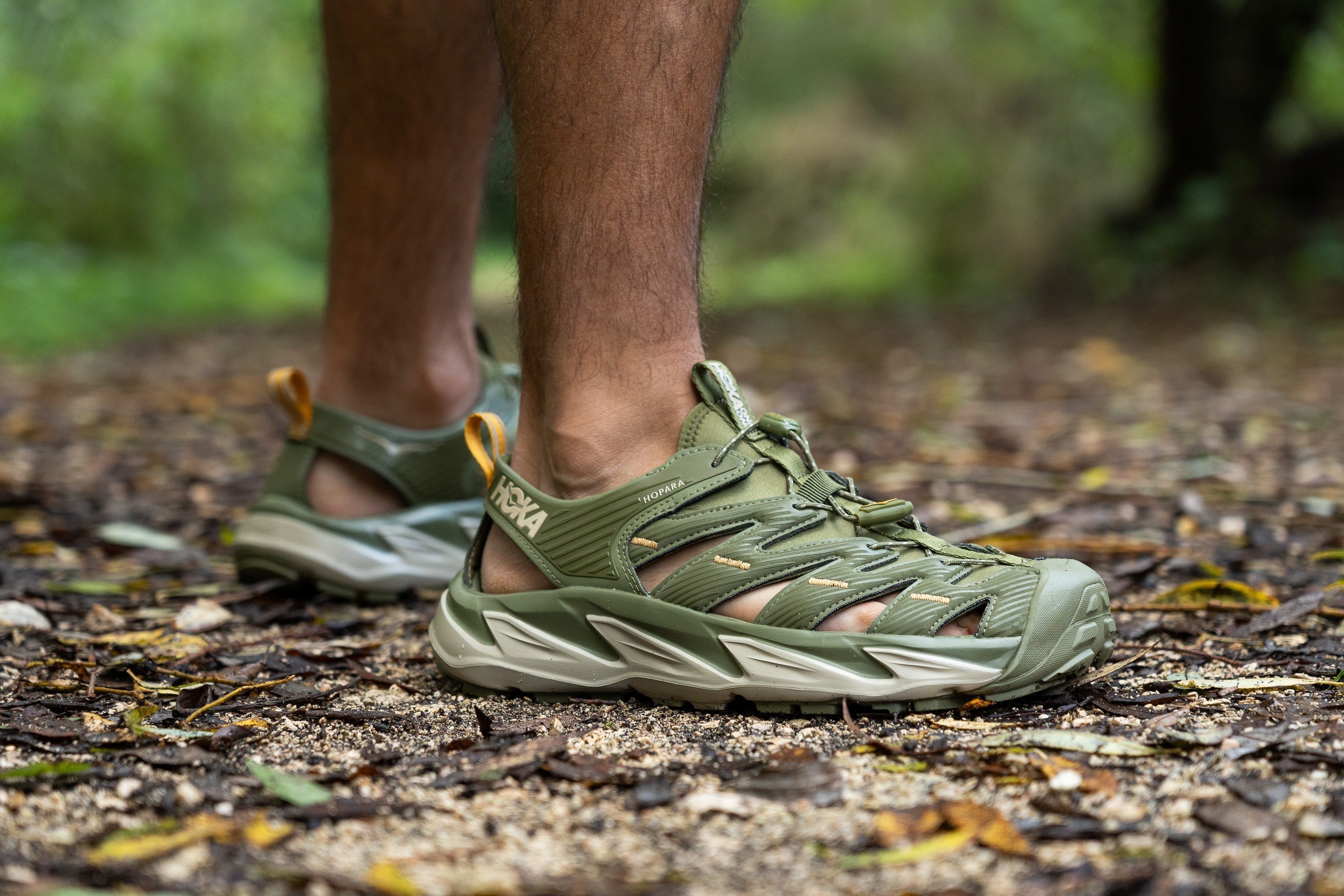
Why you SHOULD be hiking in sandals
If you’re on the fence about buying hiking sandals, these might convince you:
- Many hiking sandals can have their fit customized thanks to the adjustable straps. They are easy to put on and off.
- Hiking sandals tend to be very breathable, or at least more breathable than other types of hiking footwear. This depends on the amount of the material they have and the type of the material, but usually, there’s a lot of open space for your feet to breathe.
- They also tend to be very quick-drying!
- They are lightweight! Especially when we’re talking about those made for light hikes and well-maintained trails.
- Hiking sandals are easy to maintain, wash, and sometimes even repair!
- They are cheaper than hiking shoes or trail running shoes.
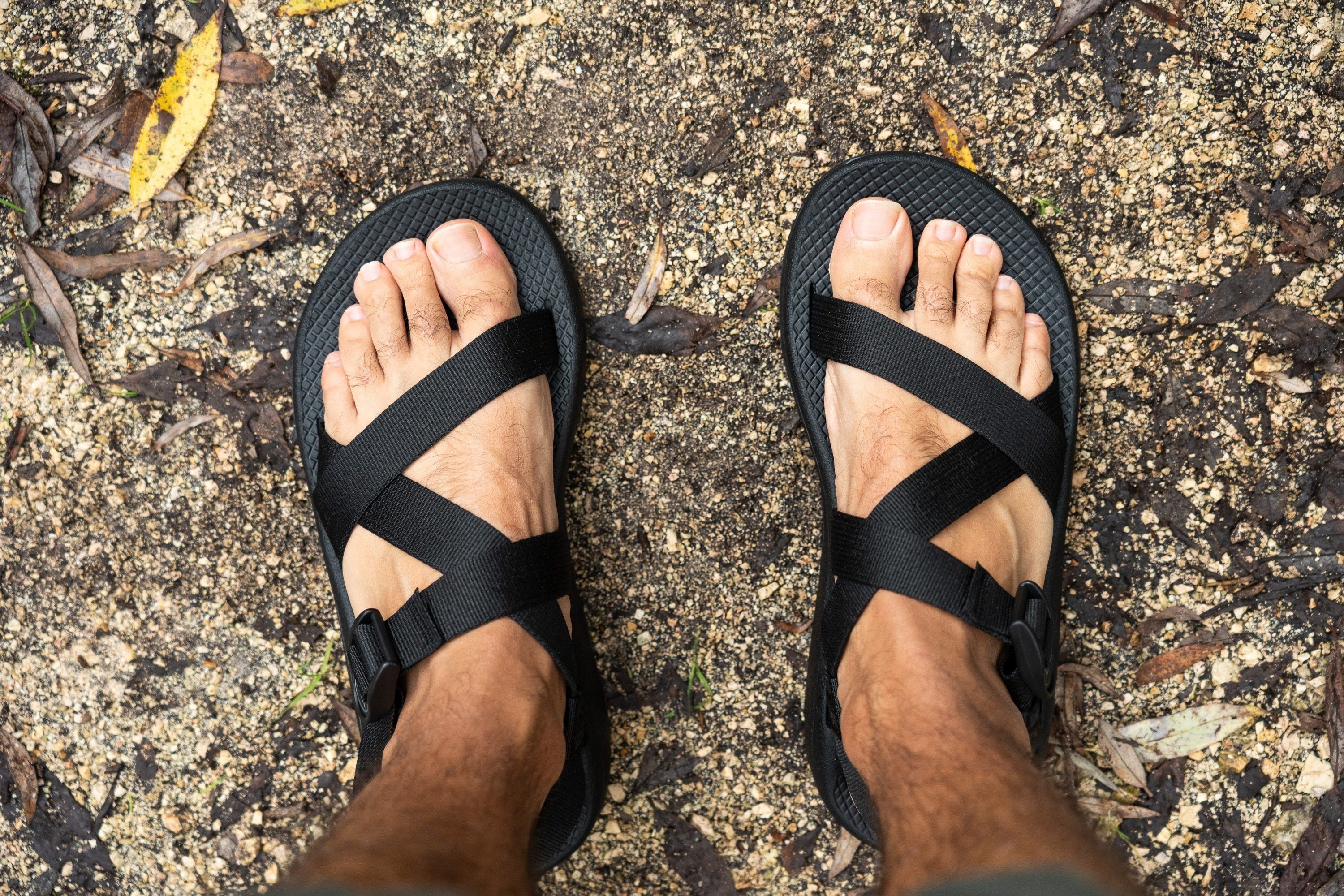
Caution: Must know BEFORE buying hiking sandals
- Generally speaking, hiking sandals are not meant for demanding hiking, especially not for backpacking. There are only a few models that can be used for backpacking, but even then, you have to prepare for that adventure. It is best if you have strong feet and strong ankles and if the terrain is not extreme.
- You’ll get weird tan lines.
- Exposed feet mean risk of injuries. Sandals offer much less protection than hiking shoes and hiking boots.
- Debris, rocks, sticks, scree, they are all your enemy. They can easily get stuck between the sandal material and your feet. You can’t use gaiters with sandals.
- You might get very cold when the weather changes suddenly and the temperature drops.
- Get used to dirty feet. Dirty toes, dirt under the nails. Even if you wear socks with hiking sandals, your feet will still get dirty; there’s no way around it.
8 things to pay attention to in hiking sandals
There are 8 things to consider when buying hiking sandals:
- Closure type: closed or open-toe
- Upper type: straps, braids, or regular
- Purpose: do you need sandals for regular hiking, casual use and light hiking, water hiking, or backpacking? Many things depend on this.
- Depth of lugs (grip): from no lugs to very deep lugs. The shallower the lugs, the less we recommend hiking in the sandals (especially when sandals don’t even have the lugs).
- Midsole softness and shock absorption: comfort is directly related to these 2. Hikers usually relate softness with comfort, but firmer midsoles offer more stability and those with good shock absorption are better for heavier options (both hikers and backpacks)
- Outsole hardness: softer outsoles are usually stickier, but harder outsoles are more protective and durable
- Flexibility: stiff sandals are great for terrain covered with debris, but more flexible sandals allow for more natural foot movement
- Weight: usually, lighter sandals are meant for lighter hikes and maybe even casual use, while havier sandals which have hard outsoles, firmer midsoles, and a lot of protection, can be used on moderate hikes.
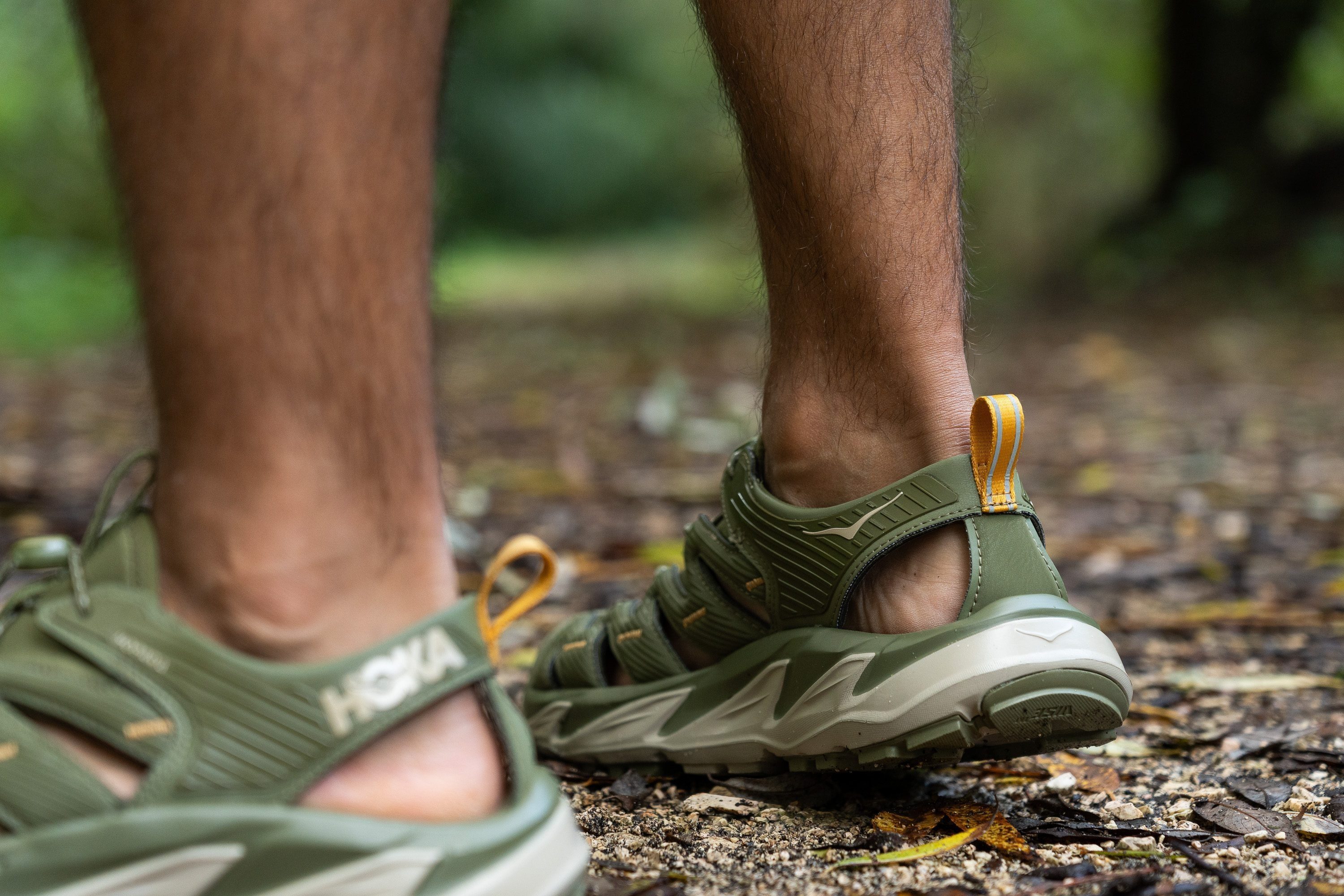
We dig deep into all of these features below.
Which is better: Closed-toe or open-toe hiking sandals
There are 2 types: closed-toe or open-toe.

And, if the toes are open, you can choose between a toe post, a finger loop, or a simple open toe.
Closed-toe hiking sandals are recommended for hikes where you need protection at your toes. They have a toe bumper, just like hiking shoes, hiking boots, and even some trail running shoes. Open-toe sandals offer more freedom of movement for your toes but are also less supportive and protective.
Straps, braided upper, or regular upper?
Straps are great because they are customizable; they can be loosened up or tightened. Sometimes, even in more than 1 place (around the heel, over the instep, and/or above the toes). This works especially well for hikers with narrower or wider feet.
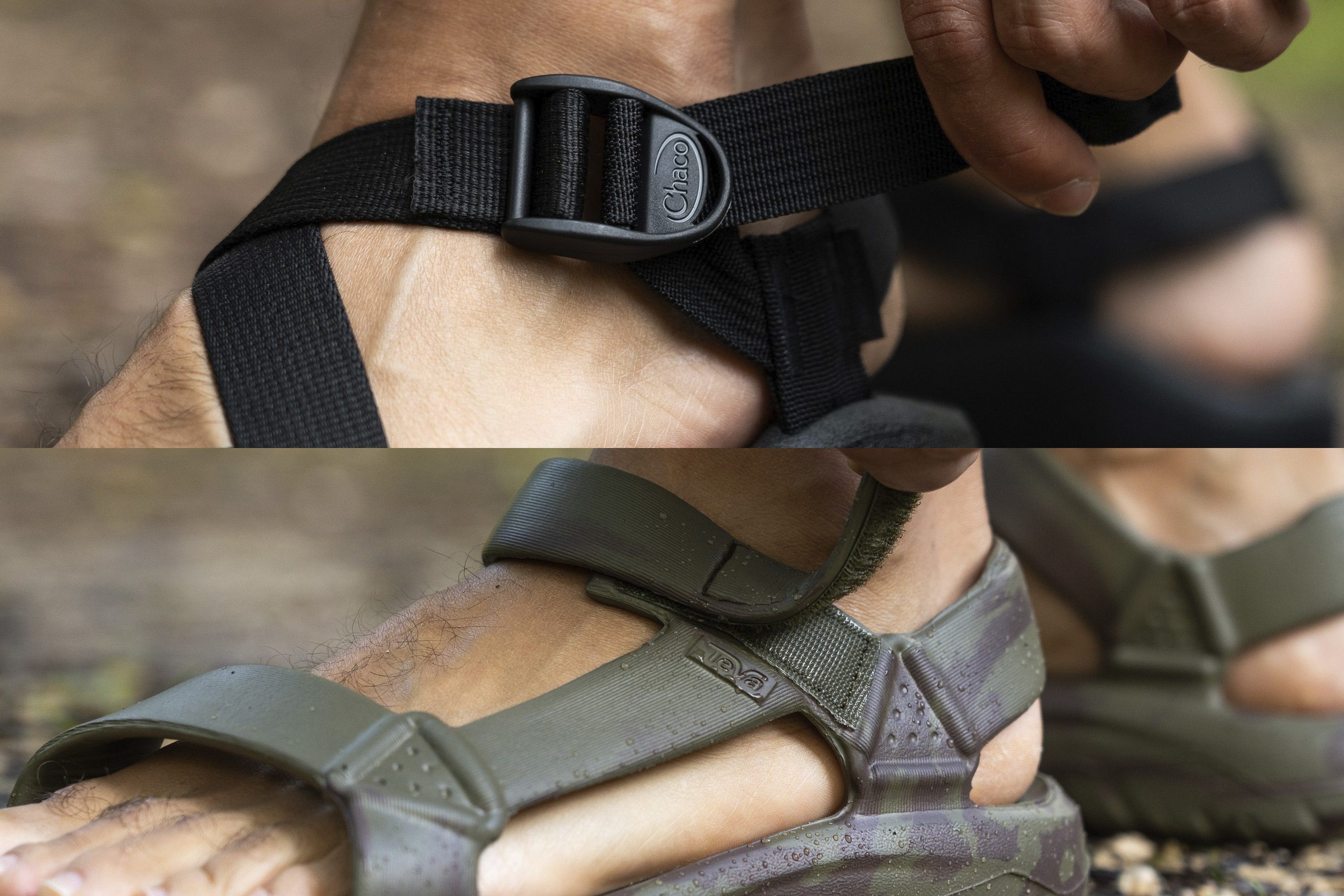
Braided uppers work wonderfully with a single lace pull (quick lace) but don’t allow for that much customization. They offer more protection that the strappy sandals but less than those with regular uppers.
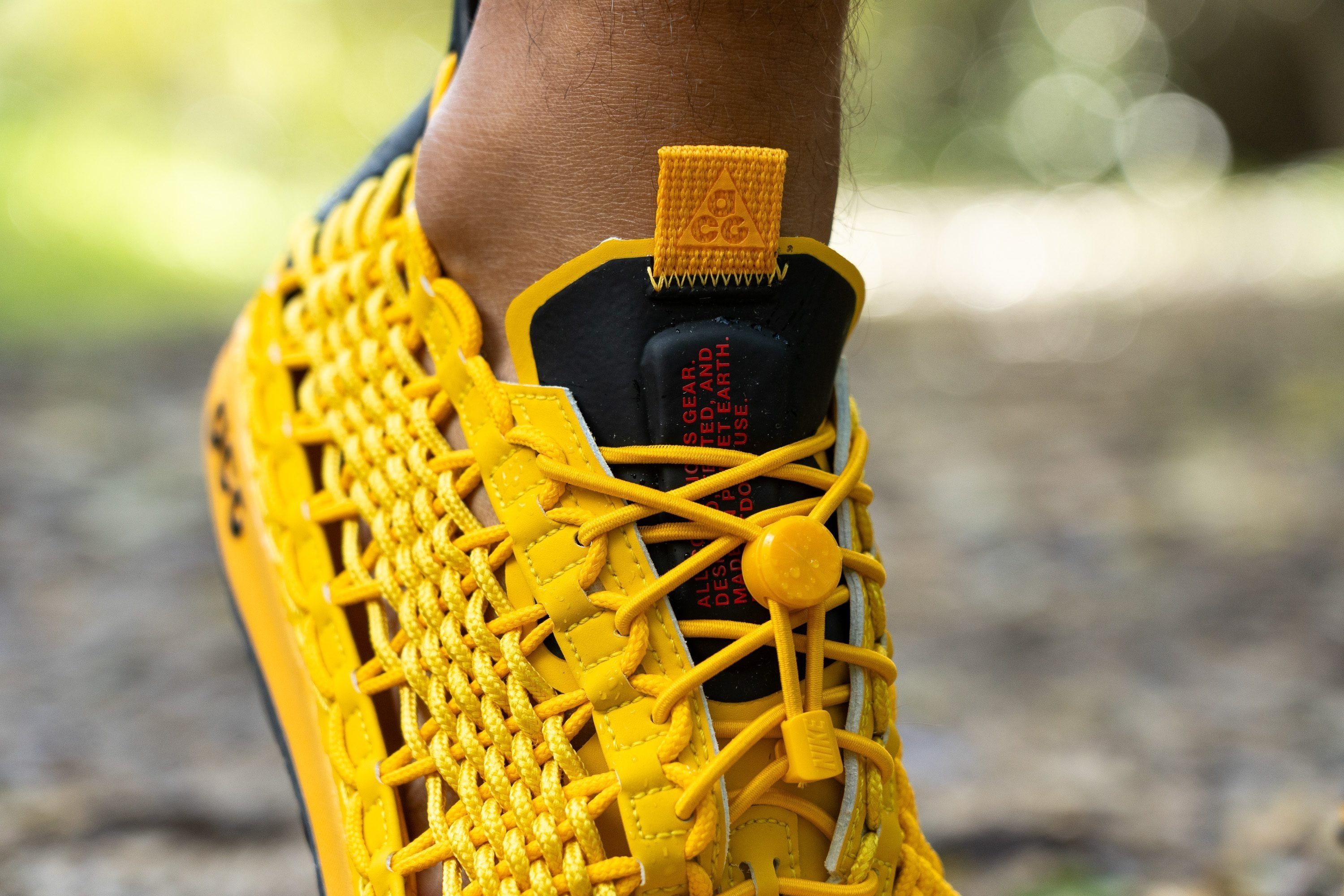
The regular upper is not customizable, but it is also the most protective and very durable as it’s often made of leather or very thick synthetic materials.
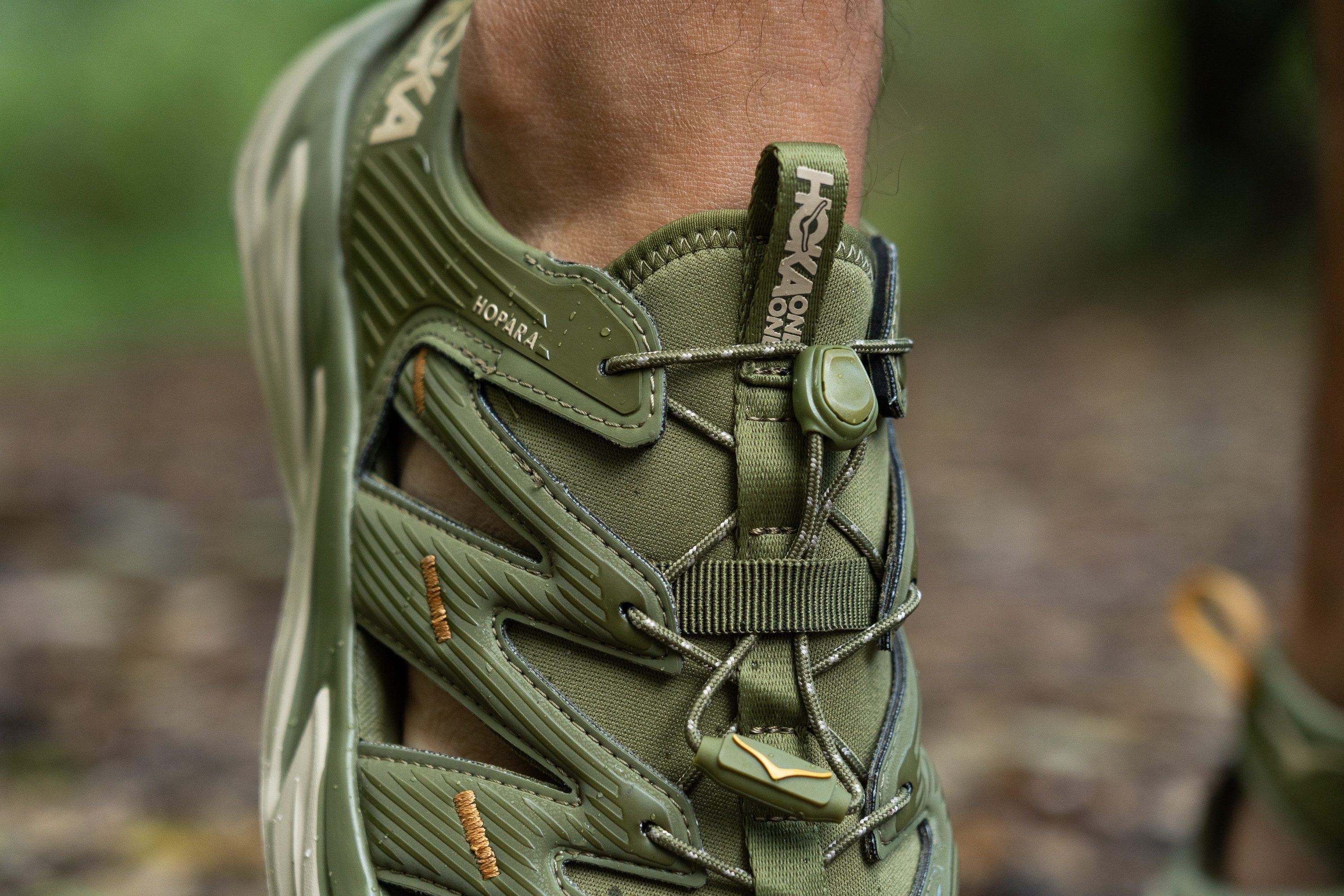
What you plan to do: water hiking, backpacking, day hiking?
Sandals are often used for water hiking, day hikes, and light hiking. Knowing what you plan to do basically dictates what to focus on when buying a new pair of hiking sandals.
Water hiking sandals: what to look for
If you plan to hike near water, across some streams, maybe use the sandals when kayaking, water hiking sandals are a great idea. Here are a few features to consider:
- Materials should be quick-drying. If not, they can start smelling badly, plus they will keep wet for longer periods of time, which might result in your feet getting cold. Synthetic materials dry faster than leather. Anti-microbial materials are a bonus because of all the moisture!

- Quick drainage! Look for sandals with a lot of areas where the water could escape. If there are drainage holes present on the upper, it is best if they are lower to the midsole so that even low levels of water can drain out.
- Best not to slip or slide! Because of this, choose the sandals that keep your feet locked down to the maximum. Which design you will choose (straps, closed toe, etc.) depends on the shape of your feet. If you actually plan to hike through the water, where a lot of rocks can hit your legs, go for the close-toe design so that the toe box keeps your toes safe.
- Grip! Some outsoles are better for wet surfaces, others for dry surfaces. Look for the former.
Backpacking hiking sandals: tread lightly
As mentioned above, hiking sandals are usually not recommended for backpacking. This is because backpacking involves multi-day hikes, long daily mileages, and heavy backpacks.
All of that asks for as much support and stability as you can get, and hiking sandals tend not to deliver, especially not when compared to hiking shoes and boots. However, some sandals can be used for light backpacking.

In case you want to go backpacking in sandals, we recommend looking for:
- Secure lockdown. Make sure your feet don’t slip or slide.
- Cushioning. Look for a lot of support, which means firmer midsoles. Carrying a heavy backpack means the 2 of you weigh more, so it is best to have more materials below your feet to respond to your weight and pressure. We don’t recommend minimalist (very flat and low to the ground) sandals.
- Stiffer outsoles. In the long run, they provide more support and stability. This comes in handy when the terrain gets rougher.
- Best if they can be easily adjusted in case your feet need a bit more room due to swelling after a full-day hike.
- Some sandals have a shank placed in the midsole or between the midsole and the outsole. Shanks offer more stiffness, which means such sandals are more supportive and comfortable in the long run.
- Consider looking for anti-microbial materials, as you might sweat a lot during long hikes, especially if backpacking in summer.
If you want to get into backpacking, consider the safer option: getting backpacking shoes or backpacking boots.
Day hiking and light hiking in sandals
When it comes to day hiking, we recommend versatile sandals. This means they must have some grip (at least ~2 mm deep lugs) and they should fit perfectly. The rest depends on the terrain and weather.
Go for leather sandals if you want durability and protection, but choose synthetic upper (straps) if you prefer something that is quick-drying and lightweight.
Light hiking is the lightest hiking, which means you’re basically getting hiking sandals for very short and easy hikes on hard-packed trails, even terrain, and maybe even popular maintained trails. In this case, you can choose shallow lugs and no need to worry about more expensive features like the type of material (leather or waterproof), whether your sandals have a shank in the midsole to make them more supportive, etc.
Lug thickness: lab measurements and our recommendations
The grip depends on the outsole: how sticky it is, whether there are any lugs, how deep they are, and what’s the orientation of the lugs. Because hiking sandals are more oriented towards lighter hiking, we will discuss only the hardness of the outsole and lug depth here.

Depending on where you plan to hike, we recommend:
- Deep lugs (3mm and deeper) if your hikes involve soft ground, maybe even a bit of mud
- Shallow lugs (less than 3mm) if you plan to hike on well-maintained trails that have no extreme details
- No lugs if you don’t plan to actually hike in the sandals.
In the lab, we measure the thickness of the lugs with a caliper.
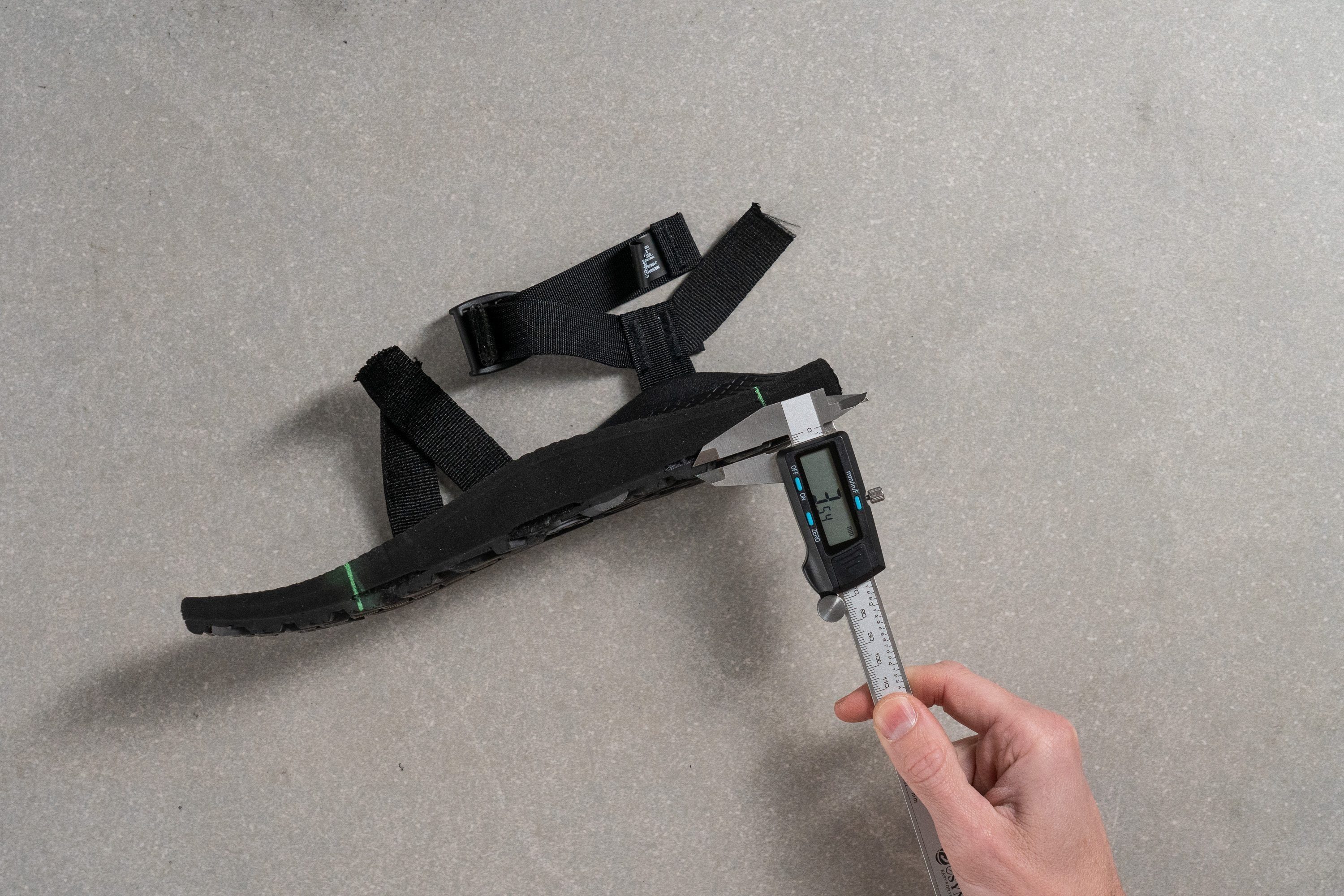
We also measure the hardness of the outsole with a durometer. The harder the rubber, the higher the number on the durometer.
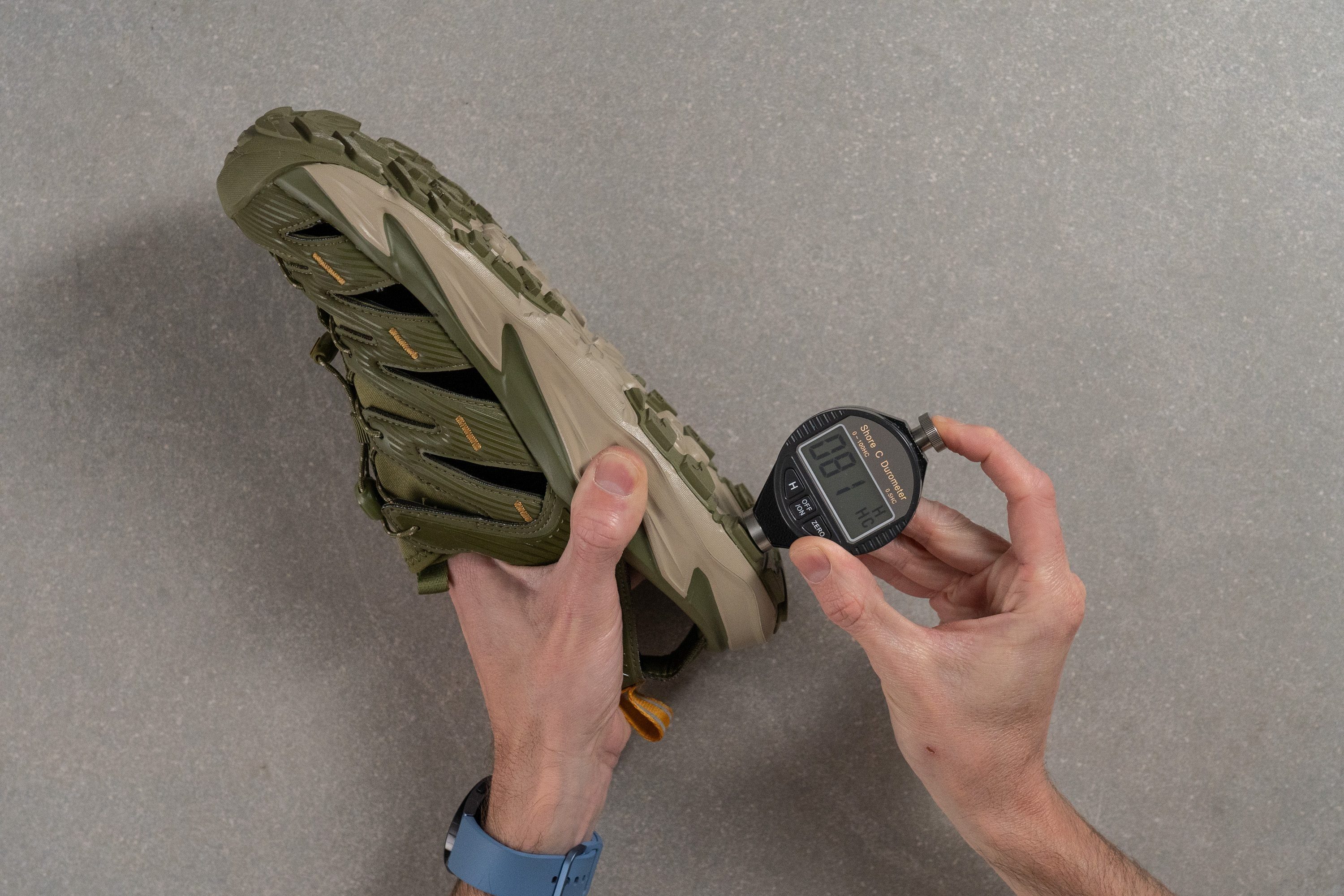
It’s also important to note here that the harder rubber is usually more durable and protective. It’s dense, so the chances of sharp rocks cutting through a hard outsole are smaller than when you hike in softer outsoles. On the other hand, softer outsoles tend to be more flexible, pliable, and stickier.
How durable are hiking sandals?
While the durability of hiking sandals is often worse than that of hiking shoes and boots, it still isn’t something that should be forgotten. Not all sandals have a toe box or heel padding, so we can’t measure the durability of those areas on all of them, but we can measure the durability of the outsole. And this is an excellent indicator of what type of terrain the sandals can be used on.
We measure the durability by pressing our Dremel against different parts of the sandals (toebox, heel counter, outsole).
Testing the durability of the toebox
When we test the durability of the toebox or the heel padding, we rate it on a 1-5 scale based on the amount of damage our Dremel has made.
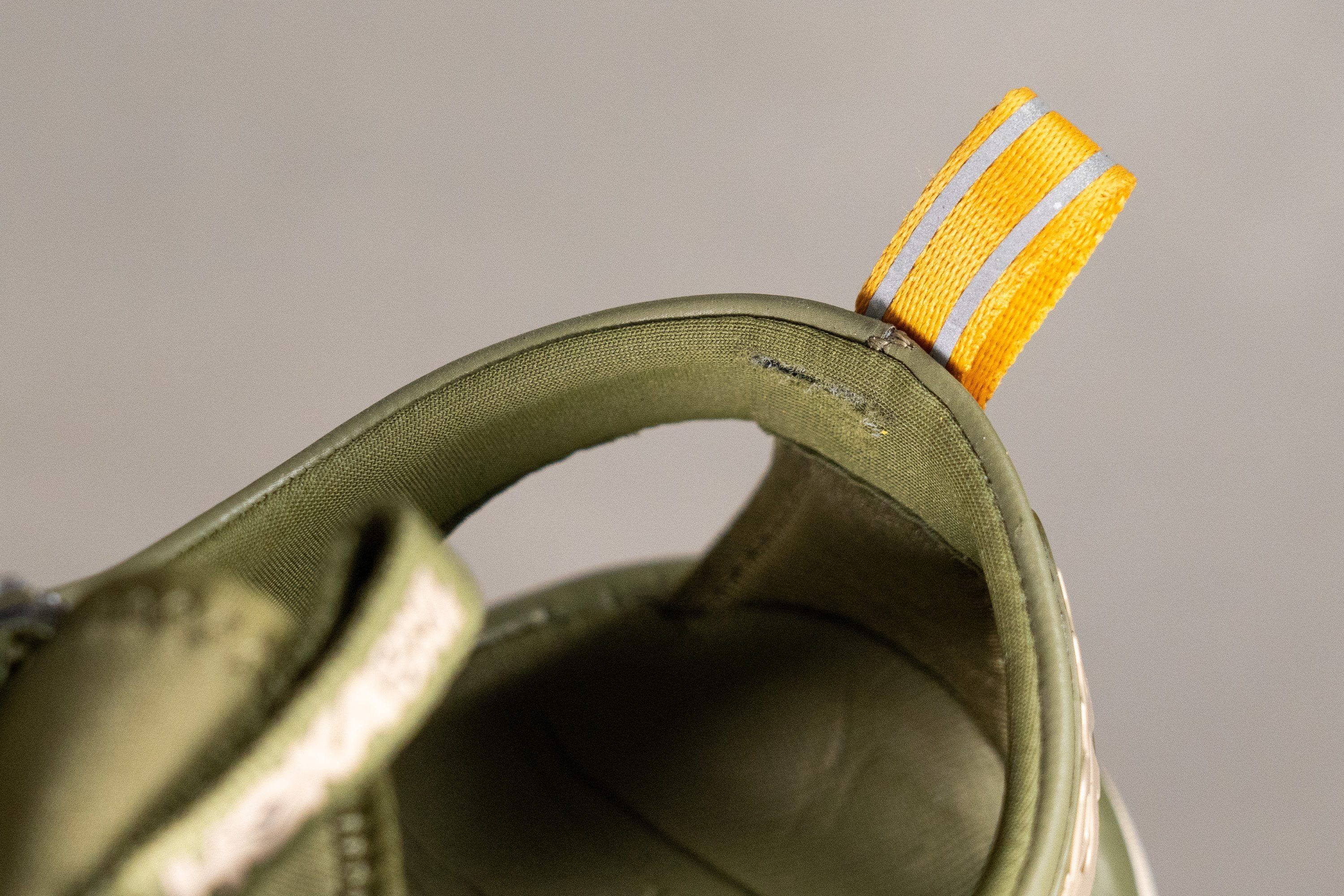
However, when we test the durability of the outsole, we don’t have to assess the damage; we can measure it precisely using a tire tread gauge. The higher the number on it, the bigger the damage. Or, the bigger the dent we’ve made, the less durable the outsole.
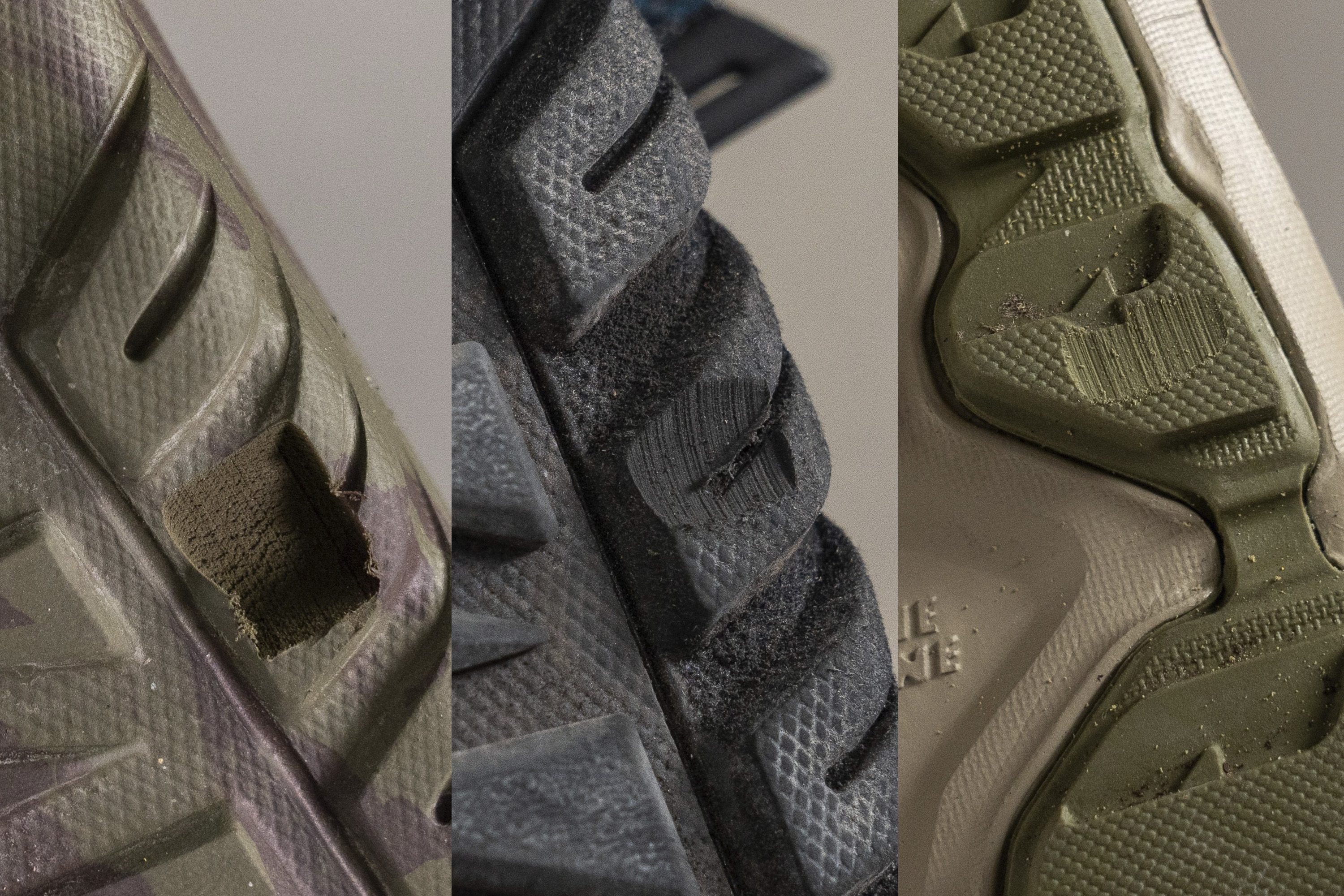
Flexible or stiff: which is better?
When hiking sandals are flexible, they actually allow us to move more freely. They bend in sync with our feet with less disturbance. Stiffer footwear, on the other hand, while it doesn’t support that natural-movement feel, it does offer more support and stability.
So, it’s up to a hiker to decide what they will prioritize:
- More flexible sandals, which allow more freedom of movement and support the natural bending of feet
- Stiffer sandals, which are better for terrain covered with debris as they offer more protection and stability, which results in less foot fatigue (at least) on such terrain
We test the flexibility of hiking sandals by clamping their toebox and bending the heel to 30 degrees using a stiffness-testing machine. We read how much force was used to bend the sandal: the more force used, the stiffer the sandal.
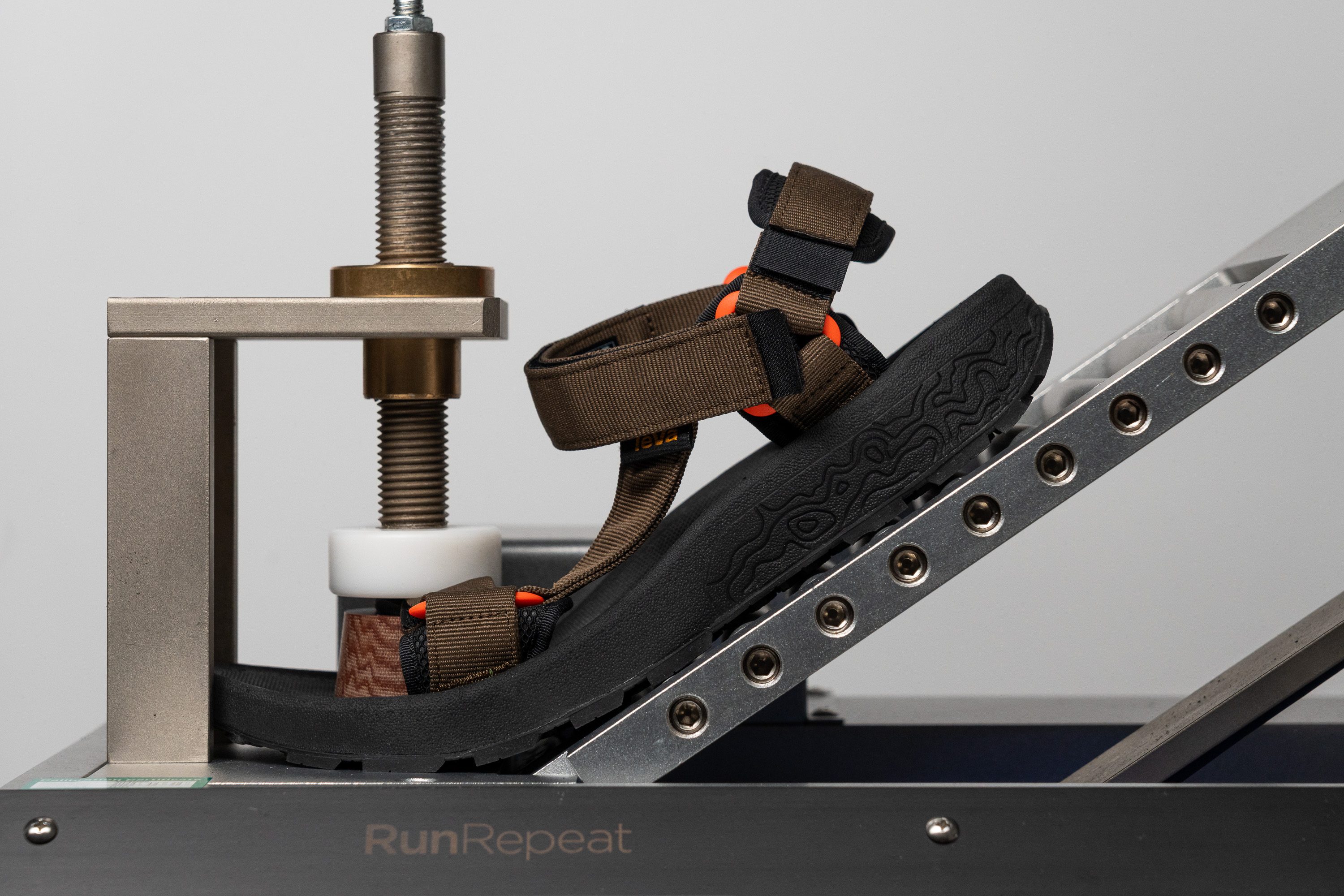
Softer or firmer sandals? Lab results and recommendations
There are 2 common materials used for midsoles in hiking sandals:
- EVA: usually soft, flexible, lightweight. It is not supportive enough for more serious hikes as it compresses over time. Short for ethylene vinyl acetate.
- PU: very supportive, usually found in backpacking sandals and hiking shoes and boots. It is more durable but also heavier, and it might require some break-in time. Short for polyurethane.
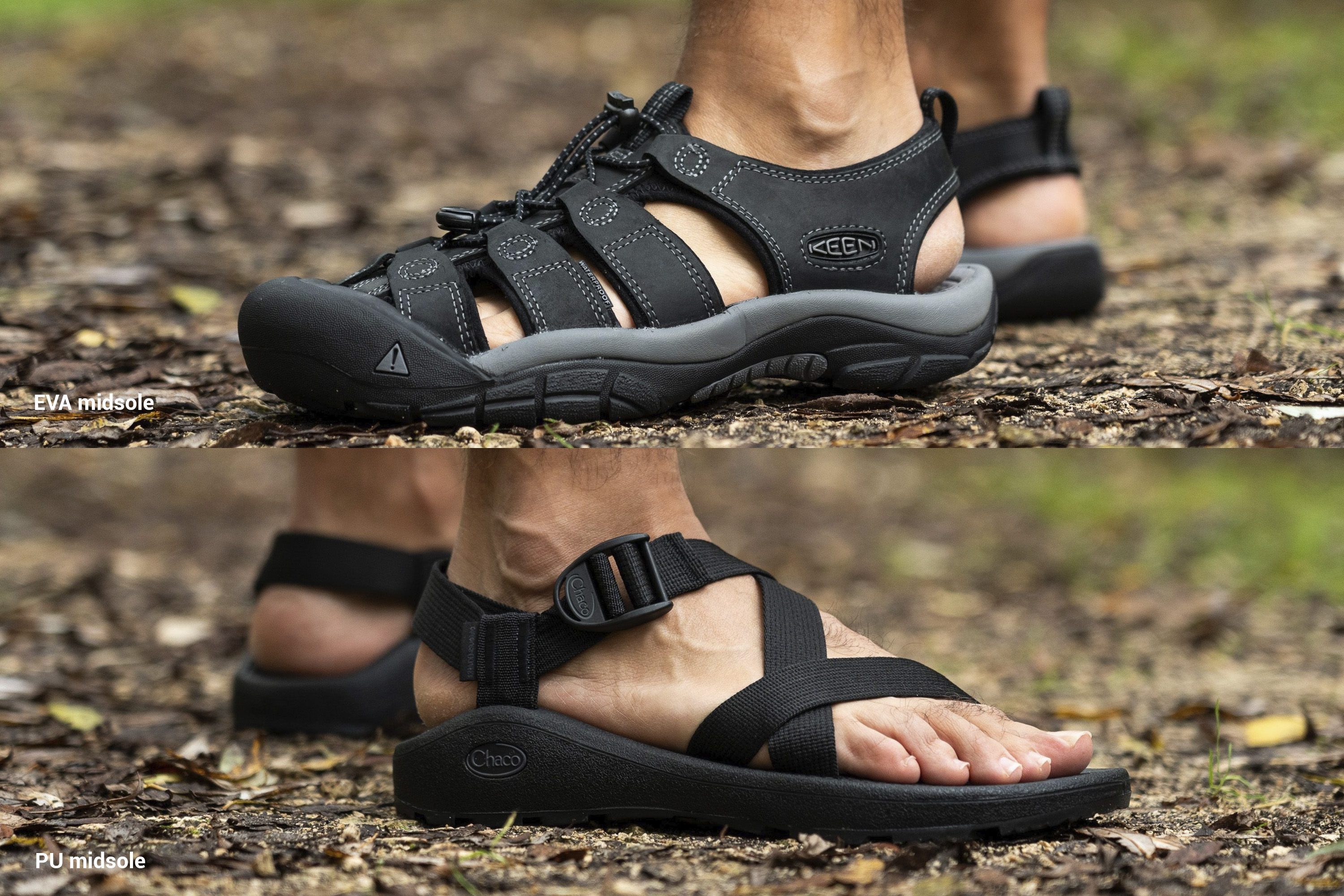
In our lab, we test the softness using a durometer. The lower the number on the durometer, the softer the midsole.

Usually, we'd say that softer is more comfortable and firmer is more supportive. However, we actually recommend looking at the shock absorption. This feature tells us how protective the midsole is in terms of how well it dampens the impact forces. So, as you stomp along the trail, a good midsole (with high shock absorption) deals with the impact instead of your legs.
Testing the shock absorption in hiking sandals
When our feet hurt, it might be because of poor shock absorption. You can also imagine hiking barefoot or in minimalist (very low stack height) sandals. There's no protection; the midsole is non-existent or not thick enough to dampen the impact, so it's on your legs to do so. Usually, you then hike more slowly or try to land on the forefoot because your heel hurts. So, we should look for good shock absorption for a care-free hike!
Note: Anything above 95 SA is considered moderate, and above 110 SA high shock absorption.
Lightweight vs. heavy hiking sandals
Lightweight sandals are great because you barely feel them on the feet and they inspire that feeling of freedom and traveling light and naturally. However, with light weight usually comes less protection, less stability, and the ability to hike over moderate trails (not to mention the demanding ones).

We measure the weight of every sandal in our lab.
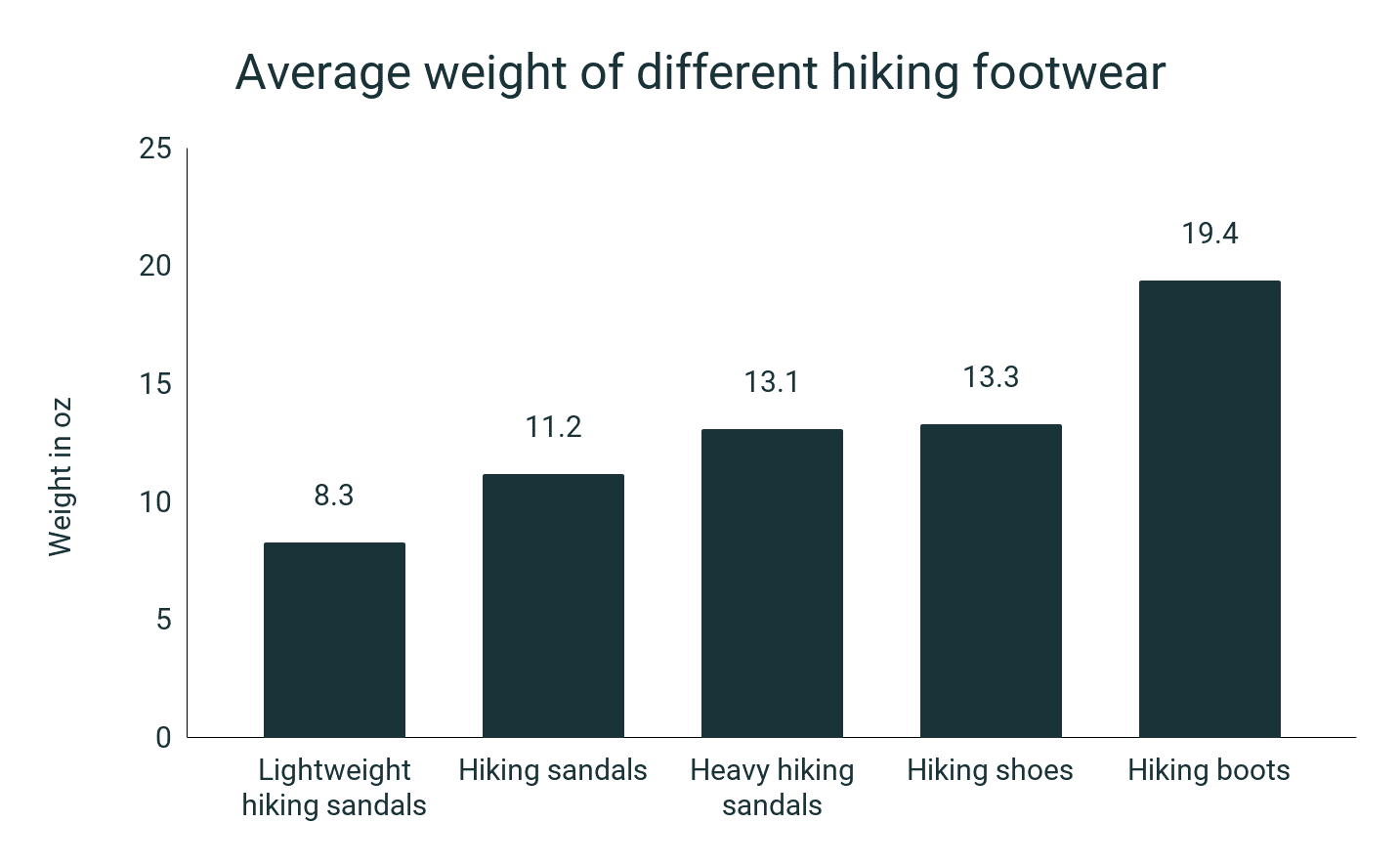
Here are a few numbers from our current database to create context around the weight of hiking sandals:
- Average weight of hiking sandals: 317.0g
- Average weight of lightweight hiking sandals: 236.6g
- Average weight of heavy hiking sandals: 371.3g
- Average weight of hiking shoes: 377.8g
- Average weight of hiking boots: 549.9g
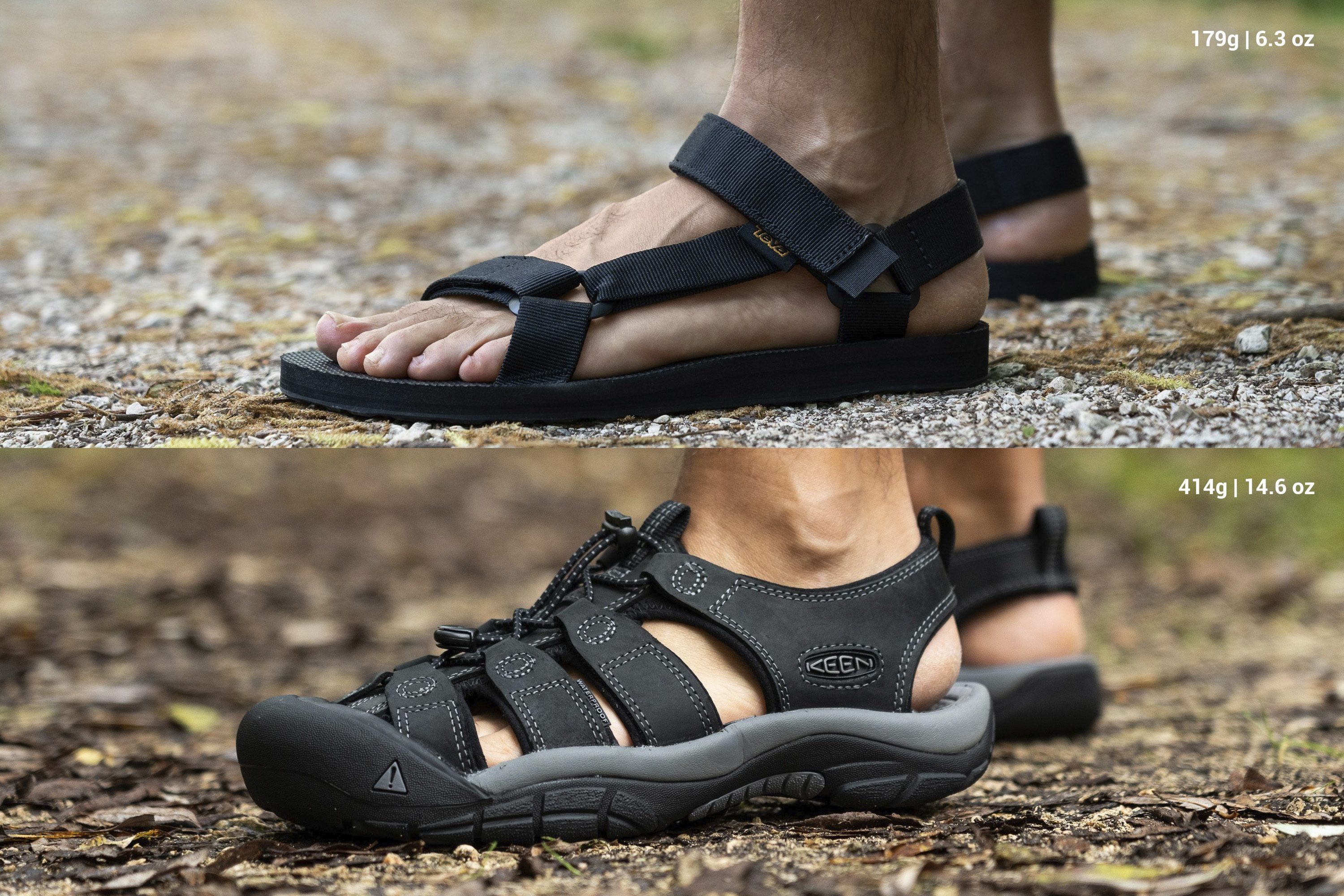
Prices of hiking sandals: a comparison
The price of hiking sandals depends on the upper materials used (leather is usually more expensive than synthetic) and their purpose (more durable and grippier sandals are heavier and include more expensive materials).
For context, here are a few data points from our database:
- Average price of hiking sandals: $90.8 (for synthetic sandals: $86.2)
- Average price of hiking shoes: $129.9
- Average price of hiking boots: $196.6

If you’re on a discount hunt, check out our page dedicated to deals on hiking sandals.

